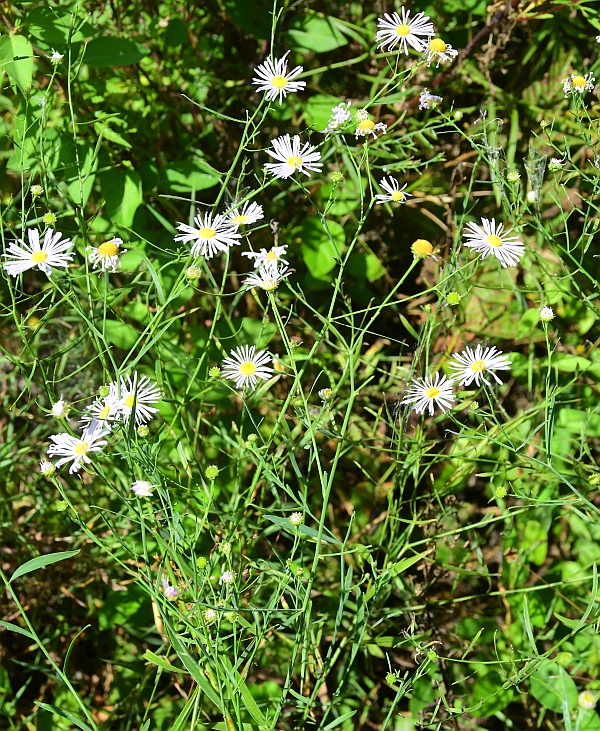Boltonia diffusa Elliott
Doll's Daisy

Native
CC = 7
CW = -3
MOC = 9
© SRTurner
Boltonia diffusa ElliottDoll's Daisy | |
 |
Native CC = 7 CW = -3 MOC = 9 |
© SRTurner |
|
Family - Asteraceae/Astereae Habit - Perennial forb, fibrous-rooted, producing basal offshoots and/or elongate rhizomes. Stem - Ascending, to 1.5 m, with numerous loosely ascending branches above the basal 1/3, with prominent pale ridges, glabrous.
Leaves - Alternate, simple, sessile. Blades 2-12 cm long, 2-18 mm wide, those of the lower and median leaves linear to narrowly lanceolate, those of the upper leaves mostly linear, the base not decurrent below the attachment point (the stems thus unwinged).
Inflorescence - Large, highly branched, panicles of heads, usually not appearing leafy, the heads solitary at the branch tips, the branches with relativvely few linear to linear-lanceolate, leaflike bracts 0.2-2.5 cm long, 0.5-5.0 mm wide.
Heads - Relatively small, the receptacle usually 3-6 mm in diameter at flowering. Involucre 2.5-3.5 mm long, the bracts in 3-5 more or less unequal series, narrowly oblong to nearly linear, narrowed or tapered to a sharply pointed tip or sometimes rounded to an abrupt, short, sharp point.
Flowers - Ray florets 20-50, the corolla 5-8 mm long. Disc florets 55-150. Pappus of disc florets a short, irregular crown of awns or narrow scales 0.1-0.3 mm long and 2 awns 0.3-0.7 mm long, the longer awns mostly poorly developed in the disc florets, usually absent in the ray florets.
Fruits - Achenes 1.5-2.5 mm long, the wings 0.1-0.4 mm wide. Flowering - July - October. Habitat - Streambanks, swamps, sloughs, bottomland prairies, bottomland forests, pond margins, ditches, roadsides, and moist, disturbed areas. Origin - Native to the U.S. Lookalikes - Boltonia asteroides, which is much more common; species of Erigeron. Other info. - This relatively uncommon species is found in a few southern Missouri counties, which are near the northwestern extent of its range. It is more common in states to our south and east. In appearance it strongly resembles B. asteroides, and in fact can be difficult to distinguish from that species. Defining characters include leaves which are narrower and heads which are smaller than those of B. asteroides. The specimens above, while conforming to the morphometrics listed in Yatskivych's Flora of Missouri for B, diffusa, leans toward the larger side of the listed ranges and may represent a hybrid of the two species. Photographs taken at Diamond Grove Prairie Conservation Area, Newton County, MO, 9-5-2024 (SRTurner). |